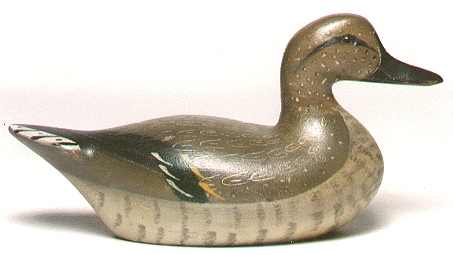| Bergman thoroughly
enjoyed hunting ducks on the lower Columbia River from his double-ended duck boat. He
never used a blind but had the ability to remain perfectly still until the birds were in
range. He hunted a lot with Ted Anderson, Eli Gustin (father of the famed duck boat
builder) and Bill McGregor, who bought the well-known McGregor’s Island in the early
1900;s. Bergman’s wood working talents contributed directly to his decoy carving,
making him the area’s premier carver. From the early 1900’s to 1920
Bergman’s decoys were fashioned after Mason Factory Premier and Challenge grade
models. Afterwards his own personal style began to evolve: by 1926 there was no mistaking
the beautiful Bergman design. |

Bergman hen Teal 1930 outstanding original paint
|